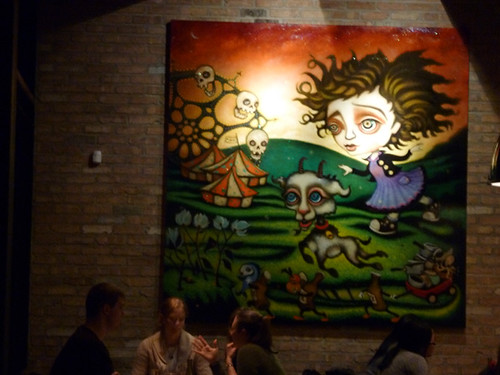
I liked Scylla fine, I ate there twice (here and here), but didn’t necessarily think Stephanie Izard was obviously more talented than half a dozen other very talented people working at the time, and it was Top Chef more than Scylla that suddenly propelled her into name brand chef stardom.
On the other hand, I think Kevin Boehm (Boka, Perennial) is pretty brilliant as a restaurant impresario, and the two-year-long opening of Girl & The Goat was the restaurant equivalent of the PR campaign David O. Selznick managed for Gone With the Wind, a textbook example of how to create and sustain buzz. So I could easily have believed that the food at G&TG (like GWTW, it calls for initialization) would wind up seeming the lesser partner in a superbly orchestrated glittering restaurant experience bringing together all of 2010’s most desired features (celebrity chef, downtown energy, pork).
Instead, I was genuinely impressed for the first time by Izard’s cooking. She’s come into her own as a Blackbird-esque master of bold, acidic flavors that pop like Pop Rocks in your mouth; many of her dishes seemed well conceived, complex, novel and balanced. (Well, she did have two years to work on them.)
But note the “seemed” rather than “were.” I say that because the way Girl & The Goat prefers you construct your meal— and by “prefer” I mean pretty much stands there and demands it, bulldozing over any desire you display to the contrary— I never felt like I had a chance to really taste and appreciate the best of what Izard had to offer. Instead I had fleeting tastes of almost half the menu, usually only a bite apiece, which ultimately blurred together and seemed far too similar— so that I not only didn’t get to really appreciate the best of what she made, but its novelty was nearly always lost in the arrival of something 75% like it right before or after. It’s one thing to be a small plates restaurant, but divided by four, this was almost a dinner of canapes— as one of my dining companions said later, “only if you were born to a family of Smurfs would these plates be suitable for ‘family-style dining.'”
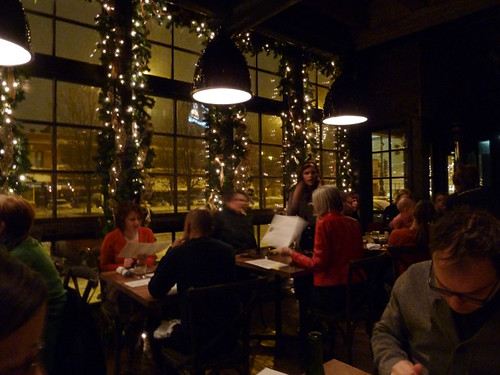
I had deliberately chosen Sunday night in order to have a more relaxed evening, relatively, but it might as well have been Saturday at 7 to judge by the firm hand with which our waitress moved things along according to her script. We were informed that there were three sections of the menu marked for vegetable, fish and meat, although there was meat on everything and fish in the vegetables (so what, exactly, was the ontological nature of the distinctions? No time to ask such things). We would be ordering two to three dishes which we would be sharing and we would order them all at once and when we hit the slightest snag at about 6 or 7 items, and needed a moment to consult over the last couple, she announced “Would you like me to read you back what you have so far?” which in fact was probably the least helpful thing she could have done at that moment, and then made us sit through an unbidden recitation of everything we’d said thirty seconds earlier. Finally, somehow, we managed to come up with a couple of additional items, and like a cartoon character, in a cloud of dust and squiggly lines she was gone.
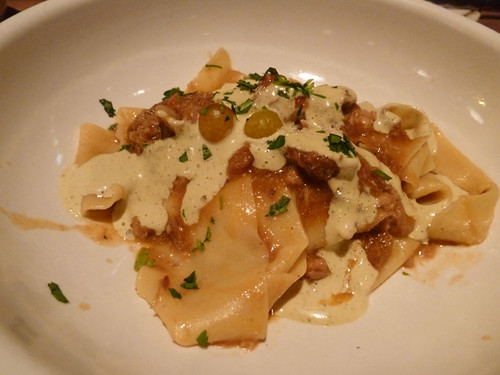
Goat, pork and veal sugo: primi for one, not four
Normally I don’t mock service in a review but in this case, it’s important to know what you’re up against. The scenario outlined, and all but mandated, will work fine if there are two of you dining together. You’ll get 4 or 5 things, a few bites of each, and probably be very happy. But if there are four of you, as there were four of us, in the name of all that is holy you must resist. Your goal, now, is not to try half the menu in tiny portions as they would have you do, making the best less memorable by mixing them with obvious second and third choices, like the Greatest Hits album of a band that really only had three good songs. It is to find what you think are the two or three things that you would like to eat, and make sure you get them.
If that means all four of you wind up ordering the sugo, say (which would be a perfectly sane choice), then by all means, everyone have the sugo. It’s not that big a plate for one, but it’s a cruel taunt divided by four. You will earn your waitress’s disapproval, but you will have had the meal I wish I had had— an actual chance to eat Izard’s hearty, dig-in-happily food, not to have been served a big savory pasta as an amuse-bouche.
And it is worth risking getting The Goat’s goat, because Izard at her best is very good indeed, in the same porky-big-flavors vein as The Purple Pig et al. but, I think, a bit more sophisticated and accomplished. The goat/pork/veal sugo is an excellent example: a number of very good places could have made the silky pasta, the deep and soothing ragu, but very few would have put tomato-sharp gooseberries in the middle of it, so that a dish that’s comfy enough to take a nap in comes with its own wake-up call. Same for a salad of green beans and beets combined with little crunchy something-or-others and bits of mild, probably oil-cured white anchovy, so that the vegetables’ freshness and crunch is beautifully complimented with the bracing freshness of the sea:

Or a tartly spicy, yet not stereotypically Mexican, braised beef tongue with “beef vinaigrette” (not exactly sure what that is, but I like the thinking) and salsa verde; any meat could have gone in that, but the accompaniments were complex and fascinating, like a mysterious beauty you see once across the floor of a cantina, and then she is gone. All these things, and probably others that night, had big bold flavors that were nonetheless accessible and totally pleasing.
But under their system, I had just a glimpse of each of them (which tells you what impression they made even in a tiny quantity) before leaving them behind in order to devote palate attention and stomach space to chickpea fritters with romesco and feta, which would be fine as bar food but were too gooey-junk foody for the start of a meal, or two modest, unmemorable scallops in pumpkin plop, or the much-lauded pig face which just seemed like rather average breakfast food to me:
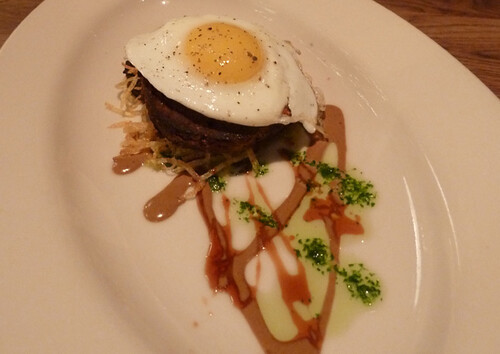
or the absurd, disastrous stone crab claw and pork belly special, $21 for a tiny amount of very good stone crab claw ill-matched with sodden pork belly swimming in a vanilla-grease sauce, which has reminded me of my vow never to eat anything savory which advertises vanilla, it just doesn’t work, you might as well make cream soda gravy.
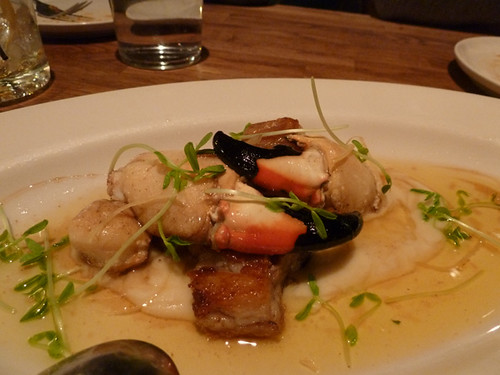
In other words, it’s a restaurant of hits and misses, like (almost) every other. But because of the system forcing me to fill so many slots with second and third tier choices (my instincts about which would be the best dishes were fairly on-target), I just had a lot more acquaintance with the misses than I needed to. If I’d ordered just a few things for myself, I’d have had a success rate of at least 67%, rather than one struggling to break 50%. And though G&TG was certainly effective at getting us to spend freely this way, I wound up the evening having tried so much of the menu that I had little curiosity about the remainder to motivate me to return.
What would get me back isn’t the chance to try ten more things, but to retry things I wish I had gotten more of the first time. So far as I could tell in my brief acquaintance with them, some of them are really quite good— and worth butting heads with The Goat a little to have your way.

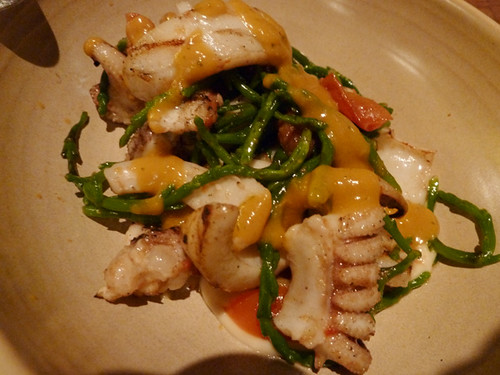
Another I liked a lot: grilled seppia (aka cuttlefish) with smoked tomatoes and sea beans.
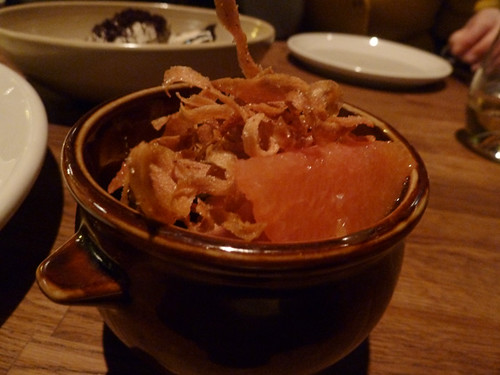
We tried three of four desserts and all of them were in the tradition of Jessie Oloroso’s work at Scylla, surehandedly integrating oddball ingredients like crispy parsnips or a marshmallow made with Ommegang’s Three Philosophers ale. This part of the meal had the highest batting average, if not the highest highpoints.


 If you like this post and would like to receive updates from this blog, please subscribe our feed.
If you like this post and would like to receive updates from this blog, please subscribe our feed.




